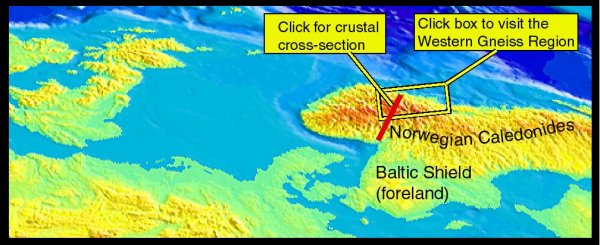
Scroll on down this page to read more. You can use the map below (together with text links) to reach specific material.

The Western Gneiss Region (WGR) of Norway is the deepest exposed structural level of an old mountain chain - the Caledonides - the last major mountain building episode in NW Europe. The orogeny actually lasted a long time - perhaps as long as 200 million years, and was associated with the closure of the Iapetus ocean and the resultant collision between various continents and blocks. Part of the final suture of this continental collage runs near the Scotland-England border. However, this web site and the related practical is concerned only with a small part of that old mountain belt. Mountain building in the Norwegian sector dates from around 400 Ma, but took several 10s Ma to happen. It was preceded by ophiolite obduction and post-dated by orogenic collapse and basin formation. Our main area of interest, the Western Gneiss Region, contains important occurrences of continental crust, parts of which were once buried very deeply within the lithosphere. Just how deeply, and how these rocks reached the surface, are issues that we shall address here. We will need to integrate metamorphic geology - which charts the evolution of pressure and temperature of the once deeply buried rocks - with regional geology and, specifically, information on timing.
You can link to the specific task list here
Timing.
Metamorphic rocks are complex. They record a history of events. So unlike many igneous rocks for example, the geochronology of metamorphic rocks is complex. Unlike for igneous rocks, simple questions like "when did this rock form?" have no meaning. A metamorphic rock may have formed and been reformed again. Consequently isotopic ages from metamorphic rocks will at best only date a specific event in the rock's history (or at worst will be some meaningless amalgamation of events with some mixture of ages). Notwithstanding these general problems, the following time constraints are the best currently available for the WGR.
Protolith: granulite-facies metamorphism in WGR dated at c. 1700Ma
Regional constraints.
The crustal shortening (i.e. following collision) must presumably POSTDATE
the youngest oceanic lithosphere found in the mountain belt.
Sources:
Information used in this exercise largely derived from the graduate studies of Maarten Krabbendam and the late Alice Wain (both from Oxford). The field data and photographs presented here were collected by Rob Butler on a short visit to the area. The primary publications are listed below, and these refer to some of the vast literature on the area by other authors:
Milnes, A.G., Wennberg, O.P., Skar, O & Koestler, A.G. 1997. Contraction, extension and timing in the south Norwegian Caledonides: the Sognefjord transect. In: Orogeny through time (eds. J-P. Burg & M. Ford). Spec. Publ. Geol. Soc. Lond. 121, 123-148.
Krabbendam, M. & Dewey, J.F. 1999. Exhumation of UHP rocks by transtension in the western Gneiss Region, Scandinavian Caledonides. In: Continental Transpressional and transtensional tectonics. (eds. Holdsworth, R.E., Strachan, R. A. & Dewey, J.F. ) Spec. Publ. Geol. Soc. London 135, 159-181.
Wain, A. 1997. New coesite-eclogite occurrences in western Norway: the nature of an ultrahigh pressure province in the Western Gneiss Region. Geology, 25, 927-930.
Krabbendam, M. & Wain, A. 1997. Late orogenic structures, differential retrogression and structural position of HP and UHP rocks in the Nordfjord-Stadlandet area, Western Gneiss Region. Norges Geologiske Undersokelse Bulletin 432, 127-139.